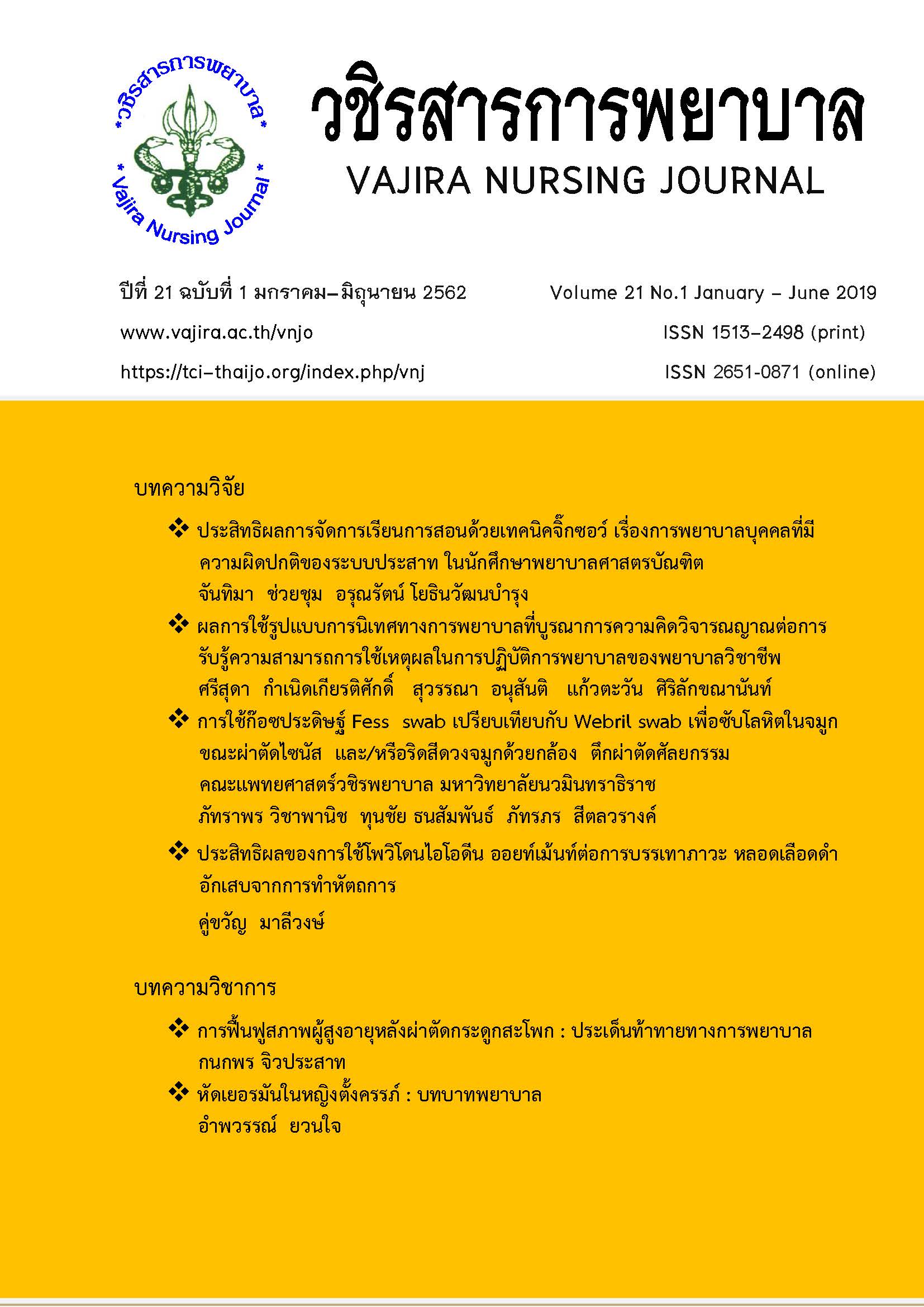ผลการใช้รูปแบบการนิเทศทางการพยาบาลที่บูรณาการความคิดวิจารณญาณต่อการรับรู้ ความสามารถการใช้เหตุผลในการปฏิบัติการพยาบาลของพยาบาลวิชาชีพ
Main Article Content
บทคัดย่อ
การวิจัยนี้ เป็นการวิจัยกึ่งทดลองแบบหนึ่งกลุ่ม วัดผลก่อนและหลังการทดลอง วัตถุประสงค์เพื่อศึกษาเปรียบเทียบคะแนนเฉลี่ยการรับรู้ความสามารถการใช้เหตุผลในการปฏิบัติการพยาบาลของพยาบาลวิชาชีพหลังการใช้รูปแบบการนิเทศการพยาบาลที่บูรณาการความคิดวิจารณญาณ ประชากร คือ พยาบาลที่สำเร็จการศึกษาบัณฑิตใหม่ ในปี พ.ศ. 2559 จำนวน 18 คน เครื่องมือที่ใช้ในการดำเนินการวิจัย คือรูปแบบการนิเทศทางการพยาบาลที่บูรณาการความคิดวิจารณญาณของ Fonteyn และเครื่องมือเก็บรวบรวมข้อมูล คือแบบสอบถามการรับรู้ความสามารถการใช้เหตุผลของ Johnson & Webber ในการปฏิบัติการพยาบาลของพยาบาลวิชาชีพ ผ่านการตรวจสอบโดยผู้ทรงคุณวุฒิ 3 ท่าน ค่าสัมประสิทธิ์ความเที่ยงของเนื้อหาคือ 0.96 วิเคราะห์ข้อมูลโดยใช้สถิติ Wilcoxon signed ranks test
ผลการวิจัยพบว่า คะแนนเฉลี่ยการรับรู้ความสามารถการใช้เหตุผลในการปฏิบัติการพยาบาลของพยาบาลวิชาชีพหลังการใช้รูปแบบการนิเทศการพยาบาลที่บูรณาการความคิดวิจารณญาณ ทั้งโดยรวมและรายด้านแตกต่างกันอย่างไม่มีนัยสำคัญทางสถิติ ยกเว้นด้านความคิดอย่างมีเหตุผลเชิงนิรนัยพบว่าการนำแผนการปฏิบัติการพยาบาลไปใช้ให้เกิดประโยชน์กับผู้ป่วยที่มีภาวะความดันในกะโหลกศีรษะสูง ผู้ป่วยโรคลมชักและผู้ป่วยโรคหลอดเลือดสมอง มีความแตกต่างกันอย่างมีนัยสำคัญทางสถิติที่ระดับ 0.05
Article Details
เนื้อหาและข้อมูลในบทความที่ลงตีพิมพ์ในวชิรสารการพยาบาลถือเป็นข้อคิดเห็นและความรับผิดชอบของผู้เขียนบทความโดยตรง ซึ่งกองบรรณาธิการไม่จำเป็นต้องเห็นด้วย หรือร่วมรับผิดชอบใด ๆ ทั้งสิ้น
บทความ ข้อมูล เนื้อหา รูปภาพ ฯลฯ ที่ได้รับการตีพิมพ์ในวชิรสารการพยาบาล ถือเป็นลิขสิทธิ์ของวชิรสารการพยาบาล หากบุคคลใดหรือหน่วยงานใดต้องการนำทั้งหมดหรือส่วนหนึ่งส่วนใดไปเผยแพร่ต่อหรือเพื่อกระทำการใด ๆ จะต้องได้รับอนุญาตเป็นลายลักอักษรจากวชิรสารการพยาบาลก่อนเท่านั้น
เอกสารอ้างอิง
กฤษดา แสวงดี และฌิชากร ศิริกนกวิไล. (2554). สถานการณ์ด้านกำลังคนด้านสุขภาพของสำนักปลัดกระทรวงและข้อเสนอแนะเชิงนโยบายในการแก้ปัญหาการขาดแคลนพยาบาลวิชาชีพ.แนวทางการพัฒนาคนเพื่อพัฒนางานการพยาบาล. กรุงเทพฯ : สามเจริญพาณิชย์.
ชะบา คำปัญโญ. (2552). ผลของการใช้รูปแบบการรายงานส่งเวรที่บูรณาการกระบวนการคิดวิจารณญาณต่อการรับรู้การใช้เหตุผลในการปฏิบัติกระบวนการพยาบาลของพยาบาลวิชาชีพ. (พยาบาลศาสตรมหาบัณฑิต, วิทยาลัยเซนต์หลุยส์).
นิสา ทมาภิรัต. (2552). ประสบการณ์การเป็นพยาบาลจบใหม่ที่ปฏิบัติงานภายใต้การดูแลของพยาบาลพี่เลี้ยง. (พยาบาลศาสตรมหาบัณฑิต, จุฬาลงกรณ์มหาวิทยาลัย).
บุญใจ ศรีสถิตนรากูร. (2551). ภาวะผู้นำและกลยุทธ์การจัดการองค์การพยาบาลในศตวรรษที่ 21. พิมพ์ครั้งที่ 2. กรุงเทพฯ :โรงพิมพ์แห่งจุฬาลงกรณ์มหาวิทยาลัย.
พิริยลักษณ์ ศิริศุภลักษณ์. (2556). การสอนนักศึกษาพยาบาลเพื่อพัฒนาทักษะการคิดอย่างมี วิจารณญาณ. วารสารวิทยาลัยพยาบาลบรมราชชนนีนครราชสีมา, 19(2) : 5-19.
ระวีพรรณ สุนทรเวชพงษ์. (2558). ปัจจัยที่สัมพันธ์กับการปฏิบัติกิจกรรมการนิเทศของผู้นิเทศทางการพยาบาลโรงพยาบาลภาคตะวันออก. (พยาบาลศาสตรมหาบัณฑิต, มหาวิทยาลัยบูรพา)
สมหญิง โควศวนนท์และคณะ. (2558). ผลของการเรียนการสอนโดยใช้กรณีศึกษาต่อความสามารถในการคิดอย่างมีวิจารณญาณของนักศึกษาพยาบาล.วารสารพยาบาลศาสตร์, 33 (3) : 99-108.
สุพิศ กิตติรัชดา และวารี วณิชปัญจพล. (2551). การบริหารการพยาบาลสู่คุณภาพการนิเทศการพยาบาล. = Nursing supervision. กรุงเทพฯ: บริษัท สามเจริญพาณิชย์ (กรุงเทพฯ).
Benner, P.E.(2001). From novice to expert: excellence and power in clinical nursing practice. 2nd ed. Upper Saddle River, N.J.: Prentice Hall Health.
Bishop. V. (1994).Clinical supervision for an accountable profession.Nursing Times,90(30),35- 37.
Facione, P.A. (1993). The California Critical Thinking Skills Test manual. Millbrance, CA:California Academic Press (350).
Fonteyn, Marsha E.(1998). Thinking Strategies for Nursing Practice. New York, Philadelphia: Lippincott.
Jones, S.A. & Brown, L.N.(1991). Critical thinking: Impact on nursing education. Journal of Advanced Nursing, 16:529–533.
Johnes, B.M. & Webber, P.B. (2015). An introduction to theory and reasoning in nursing. 4th ed. Philadelphia: Lippincott.
Mayfield, M. (1994). Thinking for yourself. California : Wadsworth Publishing.
Sashkin, M. (1982). A manager ’s guide to participative management. New York: AMA Membership Publication Division.
White, E., & Winstanley, J. (2009). Clinical supervision for nurse working in mental healthsettings in Queensland, Australia: A randomized controlled trial in progress andemergent challenges. Journal of Research in Nursing, 14 (3): 263-276.


